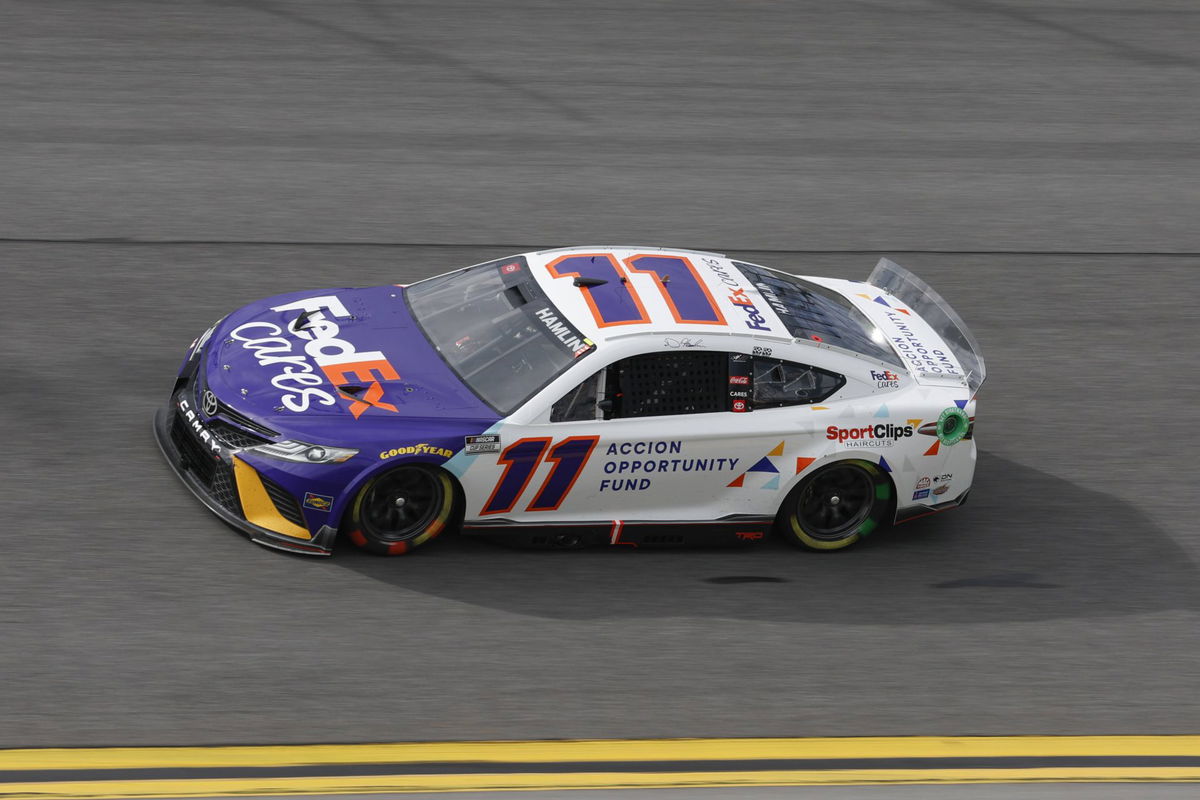
Imago
DAYTONA, FL – AUGUST 28: Denny Hamlin 11 Joe Gibbs Racing FedEx Cares Toyota during the NASCAR, Motorsport, USA Cup Series Coke Zero Sugar 400 at Daytona on August 28, 2022 at Daytona International Speedway in Daytona Beach, Fl. Photo by David Rosenblum/Icon Sportswire AUTO: AUG 28 NASCAR Cup Series – Coke Zero Sugar 400 at Daytona Icon220827207296

Imago
DAYTONA, FL – AUGUST 28: Denny Hamlin 11 Joe Gibbs Racing FedEx Cares Toyota during the NASCAR, Motorsport, USA Cup Series Coke Zero Sugar 400 at Daytona on August 28, 2022 at Daytona International Speedway in Daytona Beach, Fl. Photo by David Rosenblum/Icon Sportswire AUTO: AUG 28 NASCAR Cup Series – Coke Zero Sugar 400 at Daytona Icon220827207296
No doubt racing helmets have evolved tremendously over the years. Gone are the days when only drivers would wear headgear to protect themselves from a crash. Nowadays, pit crew members are also expected to wear helmets, safeguarding them from any loose items on the track as well as the car itself. Each helmet also has a visor, helping the crew have clear visibility during a pit stop, while also protecting their eyes.
Watch What’s Trending Now!
With technology having come a long way, Joe Gibbs Racing has released a video on social media revealing how pit helmets are customized based on the demands and conditions of a racetrack.
Pit crew members are the unsung heroes of racing teams, executing flawless race strategies to give drivers a competitive edge. While drivers get the spotlight, the crew’s quick tire changes and refueling are crucial. Equipped with the right tools, including helmets, they perform under high-pressure conditions where every second counts.
ADVERTISEMENT
Highlighting just how much pit helmets have evolved over the years, NASCAR team Joe Gibbs Racing took to social media to show the customization options at their disposal. In the video, the narrator is heard saying, “We customize our NASCAR pit helmets. The tinted visor for day races can be swapped with the clear visor for night races. The clear visor has an LED light on the top which is plugged into the helmet. The light is activated with the push of a button on the top. Then the visor can be screwed down. Then the battery can be hooked up on the back, which powers the light and the POV camera on the front.”
Unlike Formula 1 or IndyCar, NASCAR pit crew members start from the pit wall and rush into oncoming traffic when their car arrives. This requires exceptional speed, precision, and efficiency under high-risk conditions, making top-notch safety equipment, especially helmets, essential. Even with the Next-Gen car’s single lug nut, crew members must loosen it in less than a second. It’s a well-choreographed, high-pressure performance with little room for error, where the right visor and lighting can be game-changers in a sport defined by fine margins.
View this post on Instagram
ADVERTISEMENT
Joe Gibbs Racing is known for setting high standards, with drivers like Denny Hamlin and Christopher Bell consistently competing for Cup Series wins. Providing pit crews with top-notch, customizable helmets gives them a crucial edge. Earlier this year, Hamlin’s No. 11 crew recorded the fastest pit stop of the season at just 9.34 seconds for a four-tire change.
C. Bell’s No. 20 team also excelled, recording the fastest legal pit stop before the All-Star race, winning a $100,000 prize, and securing the top pit stall at North Wilkesboro. Achievements like these wouldn’t be possible without the right equipment.
ADVERTISEMENT
How much does Joe Gibbs Racing spend on tires for every race?
Tires are crucial to race performance, so NASCAR teams invest heavily to stay prepared. Joe Gibbs Racing also shared that each of their cars gets 11 sets of tires—10 new and one slightly used. With four Cup Series cars and each tire costing $531, the team shells out $93,456 per race just for tires.
Unused tires, however, are a different story. According to Denny Hamlin, Goodyear doesn’t offer refunds, leaving teams to absorb the cost. While some tires can be reused later, Hamlin points out that stockpiling them isn’t ideal, as storing tires for months isn’t the best strategy. He went on to say, “We’re not going to want older tires because they do they age. Rubber ages, and it changes compounds. It’s funny, when you get older tires, that can really mess up the car um, so it just goes to waste.”
ADVERTISEMENT
However, this is a necessary cost that teams have to incur. Buying fresh tires gives crew chiefs the option to devise various strategies during the middle of the race, which may depend on using a tire compound that needs to be available at that time.
An example can be taken from the 2023 race at Richmond Raceway, where Martin Truex Jr was forced to use scuff tires in the final pit stop, which cost him a race result. Eager to not repeat the same mistake, Joe Gibbs Racing now adopts a better safe-than-sorry approach, even if it comes at a tremendous expense.
ADVERTISEMENT
ADVERTISEMENT
ADVERTISEMENT

